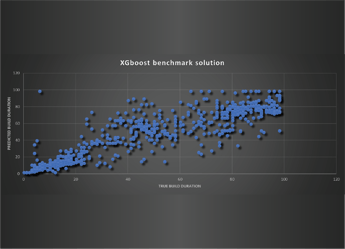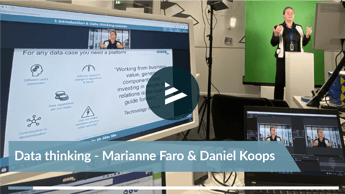The CDO as data evangelist
For many large organisations, the digitisation of products and services is in full swing, with all due consequences for the organisation and its processes and systems. Following in the wake of this digitalisation process is their development into a data-driven company. While newcomers are able to build their company around their data from the very start, for existing companies, centralizing data is a more complex puzzle – one that must be solved in order to be able to survive in a market that is changing at an increasingly rapid pace.
While the CIO or CMO generally used to be the ones preaching the benefits of a data-driven approach, the CDO is increasingly becoming the driving force in the creation of data-driven companies. After all, digitisation and data go hand in hand. As such, you suddenly find yourself at the heart of the complex technical world of data lakes, data pipelines, data factories and data science.
However, just technology alone will not be enough to get you through. It’s also about people, company culture and the organisation as a whole. As the entirety of systems, processes and departments di ffers from one company to the next, sadly, there is no standard recipe for you to work with. This process is a discovery journey that the entire organisation must embark on with the CDO as the guide.
Discovery journey
A data-driven approach means making decisions not based on assumptions but on facts. The testing and adjusting of data-based hypotheses allows you to explore validated links and correlations that you were previously unaware of. There is a signifi cant chance that these facts will have a considerable impact on your business. Only time will tell what that impact will be. After all, you don’t know what you don’t know. Therefore, you should not see the transition to a data-driven approach as a traditional project with a neat business case, but instead approach it as a journey.
"The fastest way to generate a culture shift is to make success visible"
Technology is not the most important factor in this journey. This is because the transformation into a data-driven company starts with demolishing silos. To collect and use data across the entire process chain, you must overcome barriers between departments and work in multidisciplinary teams that are in possession of both technical expertise and domain knowledge.
An environment in which team members do not hoard their own data but see data as a tool to generate advantages for the company as a whole. For larger companies in particular, this necessitates a change in company culture and a new way of thinking: an ‘explorer mindset’ and data awareness.
No magic
Getting the maximum value from all of your data is an ongoing process that your whole organisation must strive to continuously make improvements in. Perhaps the greatest pitfall of many data science initiatives is the expectation that they will immediately lead to brilliant discoveries.
Instead, the added value of a data-driven approach will grow slowly. The first step will generate insights that may not be immediately impactful in and of themselves, but which will automatically generate new questions. And with each subsequent iteration, more and better insights will arise.
Here’s a tangible example. A first iteration might be counting errors in log files to gain insight into how many interruptions of the assembly process actually take place. Text mining is then utilised to gain insight into exactly which errors are occurring. After that, process mining enables you to find out that one specific error (‘abort process’) occurs significantly often right after the code demands manual input.
You then find out that the operator is using Control-C for this input, which is the regular copy-paste code in Windows, but in this specific code functions as the trigger to abort the process. Via these types of iterations, you slowly grow from discovering basic insights towards the complete automation of the decision-making process. Make sure you have realistic expectations to start with and take plenty of time to grow.
Just get started
Much like having overly high expectations, approaching things in too much of a large-scale manner also carries risk. No large, preliminary studies; just get started. In small teams, like a start-up: pragmatic and creative. Start with a business unit that is experiencing a clear problem, like the previously described problem of the unreliable progress of assembly processes that are inexplicably aborted.
How about being unable to clearly measure your factory’s output? Or customer complaints due to an inconsistently functioning laser? All of these are issues for small, multidisciplinary data teams to dive into. Starting small also means preventing that certain values are converted early on during the data ingestion stage into the perfect measurement unit to be used in all analyses. Store data in its raw form and only assign meaning when working on specific analyses.
Make sure that plenty domain knowledge is available - context is important to be able to convert data into insights (discovery of meaning). But also make sure that if you discover insights from your data, you are able to industrialize it, to embed the data outcomes directly into your processes. For that, hire technical expertise or onboard on a pre-fab data factory. Big data and data science technologies have skyrocketed in recent years and there are virtually no technical limitations anymore. However, constructing a reliable, real-time data pipeline and implementing predictable algorithms are both a form of art and a science, and not something to start experiencing with on your own in the beginning.
Find well-trained data engineers and data scientists who know when and how to apply neural networking, image recognition models and optimisation algorithms, and who understand the dangers of using overly complicated models with too many variables (over fitting). Even so, regardless of the outside expertise you employ, your job as CDO is to keep a firm hold of the reigns yourself.
Measurable result
As with everything, the fastest way to elicit a culture shift here too is to make success visible. When data teams start generating innovative insights and input for real changes in your company, this will lead to new questions and initiatives in an organic way. Showing that analysing data has led to a ten percent increase in the reliability of the production process, for example, or has reduced the number of errors in the factory process by twenty percent, is the best way to create a data-driven company culture. As such, the focus of every initiative should be on generating measurable results as quickly as possible.
However, these measurable results cannot be determined in advance, which is why learning to think digitally and in a data-driven manner makes for a complex change. Therefore, it requires guts and a belief that it will work. A CDO who, based on that belief, inspires, facilitates, drives forward and breaks barriers to enable discussion can help employees move beyond their boundaries - to not protect their data, but to utilise it in service of digitisation. In short, the CDO as data evangelist.
Does the article trigger your curiosity and do you want to set foot towards your own successful data landscape? Have a look at the 10 data-quest guidelines.






